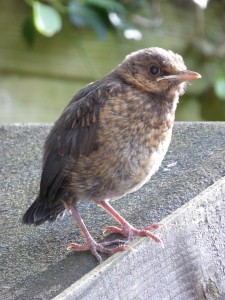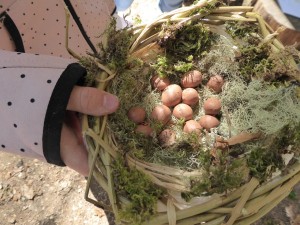
Whilst many baby birds are only now eagerly poking their heads out of nests, some parent birds are already encouraging reluctant youngsters to leave the safety of the nest. Most of our common woodland and garden birds such as robins, blackbirds, starlings and blue tits are feeding their hungry fledglings and May is a good time to observe fat fluffy chicks taking their first ‘hop and flap’ into the wider world. Here are some activities to learn about the marvels of nest building, eggs and baby birds.
There are three stages to a baby bird’s growth: hatchling (blind and naked), nestlings (fluffy and partially feathered) and fledglings (fully feathered and almost ready to fly). However, first the parent bird needs to build a nest.
Bird nest challenge: What is a nest? Where do birds build their nests? These are questions that can be explored by first looking at a variety of old bird nests. Can the children recognise some of the materials used? – dead leaves, hair, wool, moss. How have they been woven together? – some birds use mud to help stick materials together; the Dartford warbler uses spider webs! Some birds build their nest in trees, others on the ground. Woodpeckers and owls will use a hole in a tree.
For younger children, a nest cup can be easily moulded out of clay and different natural materials collected to line and make the nest cosy. Older children can be shown how to bend willow stems into a hoop and tied onto the rim of a small paper bowl. Natural materials are then collected to line the nest. Discuss insulation and camouflage, how a nest needs to blend into its surroundings.

All about eggs: The size of an egg depends on the size of the bird laying them and they come in a wonderful variety of colours and patterns. Birds that build their nests in trees generally have blue or green eggs while ground nesting birds will lay brown or speckled eggs to help with camouflage. Now you’re ready to make some eggs. Modelling clay (air dry clay) is perfect to mould an ‘egg shape’. Decide on the size and number of eggs. Use small stick to push patterns into the clay or roll the clay egg over dry earth and scrunched up leaves to camouflage them.
Woolly caterpillars: Your eggs have hatched and now you have hungry nestlings. Blue tits lay between 8-10 eggs – that’s a lot of beaks to feed! A fun activity is for the children to imagine they are parent birds and they need to collect one caterpillar at a time (as you only have a small beak) to feed their nestlings. Set up the activity beforehand by hiding different coloured pieces of wool (approx.5 cm long) around a wild space. Collected caterpillars are then stuck onto a strip of card with double sided sticky tape (the baby birds tongue). Discuss camouflage – which coloured caterpillars were the easiest to find / the hardest?
Another variation is ‘hungry cuckoo’ where the children are sparrows feeding a very large hatchling. Good discussion about parasitism.
Baby birds lunch spotter list: As your nestlings grow bigger so does their appetite. Design a shopping list of items, for younger children use pictures too, that the group can find and tick off their list. Unlike a scavenger hunt, delicate small caterpillars and young berries are observed and not collected. The group could also research and design their own list for their favourite baby bird.
Top tip: Keep a look out for broken egg shells. Birds like to have a tidy nest and will remove broken egg shells, discarding them away from the nest so not to provide clues for predators.
Fledgling watch: Bird nests are very well hidden but with a little detective work you might be able to locate one. View from a distance so not to disturb. A good technique is to watch parent birds visiting a bird table to refuel. Stop feeding peanuts as these can choke young birds. Parents will be feeding their young mainly insects. With patience, you’ll see which direction they are returning the nest to check or feed their young and maybe you’ll hear them cheeping nosily. Remember in the UK wild birds are protected by law and it is illegal to disturb any nesting bird.
New Forest Goshawk nest cam: See all the action live – eggs hatching, chicks being fed and fledglings leaving the nest. Check out RSPB ‘Date with Nature’ .
